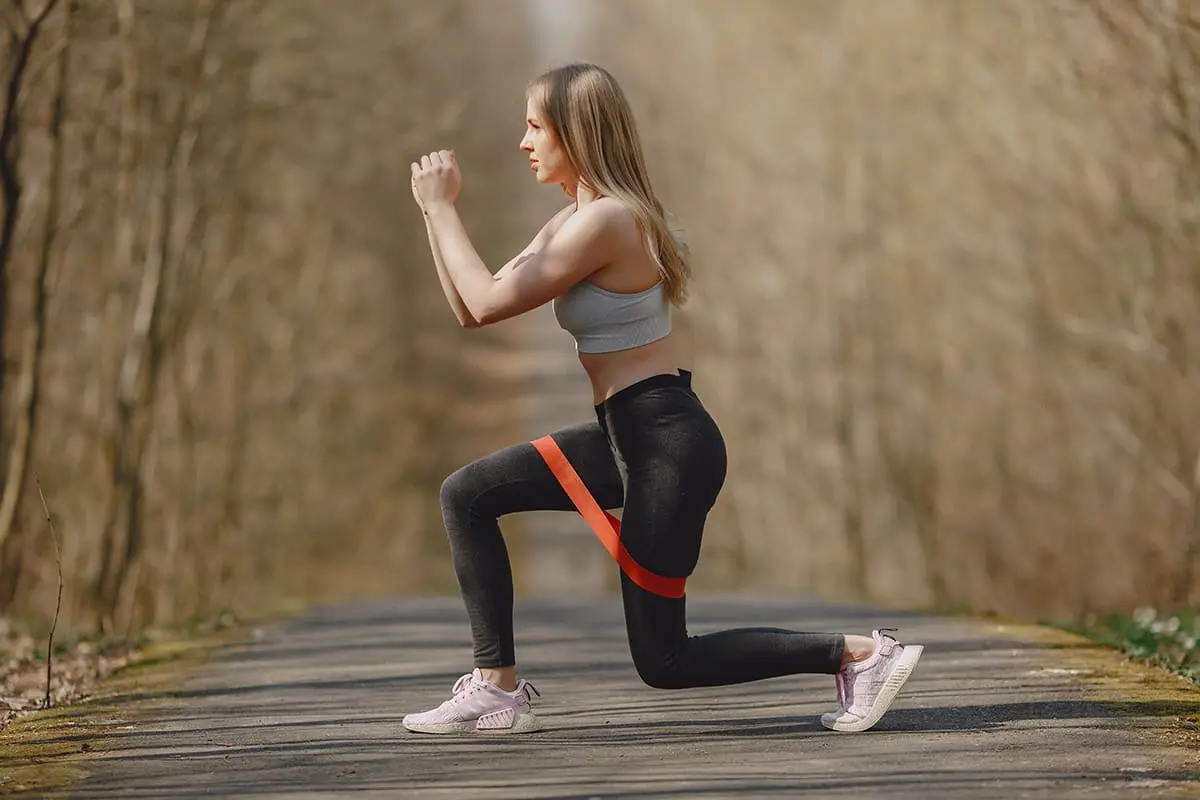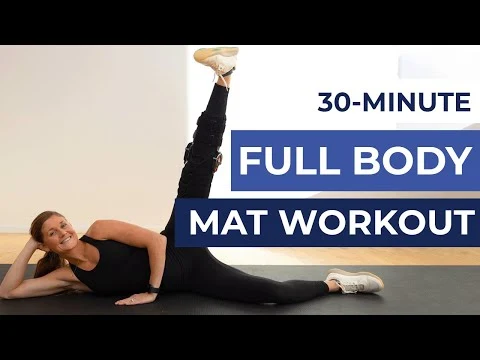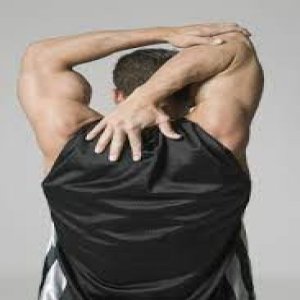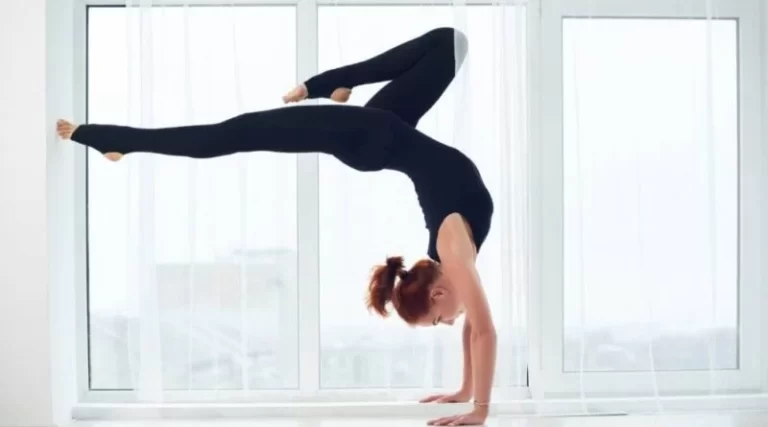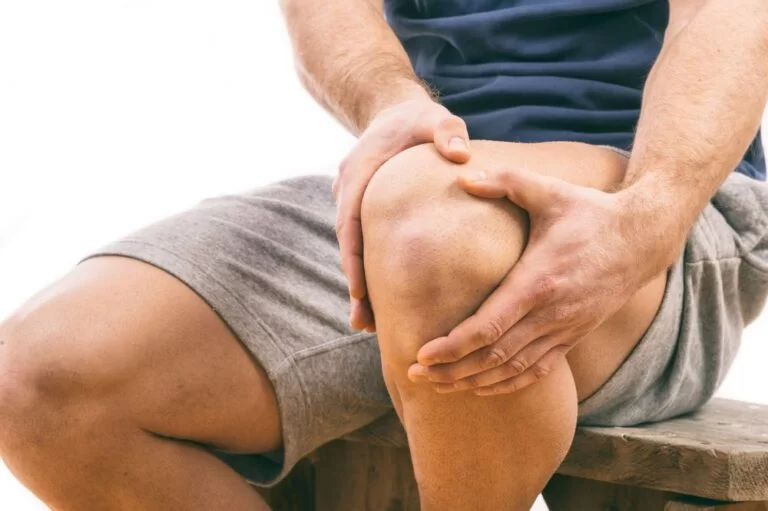31 Best Exercises for Wider Hips
Introduction
Achieving wider hips involves targeted exercises that engage the muscles in the hip region. While genetics play a significant role in determining hip width, exercise can help enhance muscle tone and shape.
The bone structure you were born with cannot be altered naturally. However, you can alter your hips and tummy to highlight an hourglass figure by exercising carefully and maintaining a balanced diet. Although body shape is influenced by genetics, some activities can help you get the hip width you want.
Focus on hip abduction exercises (moving the leg away from the centerline) and external rotation exercises (turning the thigh bone away from the midline, so the knee and feet slightly point outward) to develop the outer hip muscles.
Finding the correct activities and maintaining a healthy diet are crucial for toning and shaping your hips. In addition to preventing injury, strengthening and extending the muscles in this region will increase flexibility and stability.
When performing lower body exercises, you wrap little resistance bands—basic elastic loops—around your legs. Your body will become more curvy and bootylicious as a result of the concentric resistance’s potent activation of your hip and glute muscles.
Exercises that you can perform at home, in the gym, or on the go to develop wider hips. All you need is an elastic exercise band that fits neatly in your pocket, and they take up very little room to perform. The best part is that these workouts are made especially to give you more muscular legs, a rounder, firmer booty, and broader hips.
The most frequent error people make when trying to widen their hips is focusing exclusively on their gluteus medius. Although it is a necessary component in developing large hips, it is not the only way to get there. Not everyone will be able to achieve extremely wide hips, but even if the hourglass is out of reach, people of all body types can employ specific exercises to gain muscle and achieve a lovely pear shape.
The advantages of larger hips:
You shouldn’t increase your hip width just for cosmetic reasons. You’ll get better posture, more comfort when sitting, and increased stability because developing larger hips demands strengthening your glutes and quadriceps. The amount of muscle in your hips and thighs affects important tasks like running and walking. Excess muscle does aid in accelerating locomotion, even if studies have shown that hip bone width is not a reliable indicator of gait speed.
The most suitable exercise to widen your hips is:
The hip muscles can seem wider by strengthening and toning them with the help of the following workouts.
Side lunges
- First, take a straight stance and place your feet together.
- Step out to the side, leading with your right foot, bending your knee as you land, maintaining your left leg and foot out to the side, and making sure your bent knee is in line with your second toe.
- Maintaining your spine straight and your abdominals contracted, bend your right knee further and shift your hips back impartial.
- Your body will sag a little forward.
- Once you’ve finished the aforementioned movement, keep your eyes forward and release the breath.
- With your right foot, push off, and stand back up.
- After finishing that, return to your neutral position.
- Next, relax.
- Repeat five to ten times on the other side.
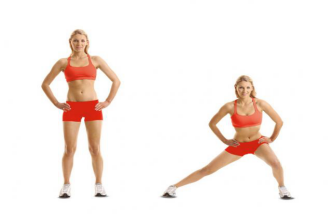
Curtsy lunges
- First, take a straight stance and place your feet together.
- Step your right leg behind your leg, keeping your chest up and your abs tight as you land, bending both knees.
- As you bend, keep both knees above your shoelaces and point your back knee down toward the floor.
- Aim to keep your left leg from straying to the left.
- It could feel as though your thigh bones are forming an “X.”
- As you take a step back to the beginning, stand tall.
- After finishing that, return to your neutral position.
- Next, relax.
- Perform complete this exercise five or ten times.
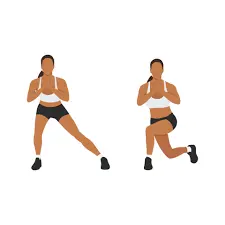
Squats
- Start with your feet spread wide enough to be comfortable.
- Your toes ought to dangle slightly.
- As though you were settling into a chair, send your hips back.
- Maintain a long spine and point your knees over your second toe.
- Maintain your abdominal muscles tight to support your spine.
- Exhale as you lower and raise your hips until your thighs are about parallel to the ground.
- Make sure your knees are pointing slightly outward and your weight is in your heels.
- As you stand up, use your glutes to press into the earth.
- Return to an upright posture by extending your knees with your quadriceps.
- After finishing that, return to your neutral position.
- Next, relax.
- Do this exercise five or 10 times.
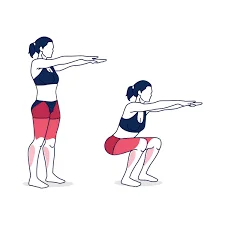
Squats with sidekicks
- Put both feet on the ground and execute the squat exercise as mentioned previously.
- Move your weight to your left foot and plant your right foot as you start to straighten your legs and stand again.
- Lift your foot off the ground by bending your right knee.
- Raise your right leg straight up and to the side; this will cause your leg to Maintaining your toe pointed forward, place it slightly in front of your shoulder.
- Return your right leg to the ground, balance your weight evenly on both feet, and lower yourself back into a squat.
- After finishing that, return to your neutral position.
- Next, relax.
- Do this exercise five or 10 times.
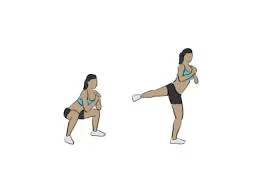
Bulgarian split squats
- Position yourself 2-3 feet away from a bench, chair, or platform, with your back to it.
- Place your left foot on the platform with your hips and knees square to the front.
- Avoid going too wide to avoid missing out on the fantastic glute squeeze.
- As you bend both knees and bring your hips toward the floor, maintain a raised chest and firm abs.
- Set both legs up straight.
- I am returning to the initial position.
- Verify that both of your knees are in line with your toes.
- Once you’re done, step back and find your neutral stance.
- Next, unwind.
- Perform this drill five or ten times.
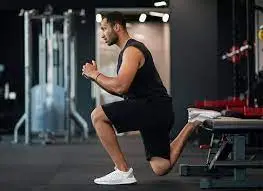
Clamshells
- Place yourself on your right side on a mat.
- With your knees bent at a 90-degree angle and your feet stacked on top of one another, your hips flexed to a roughly 45-degree position.
- Your hips and knees will be slightly ahead of each other.
- Put your head down on your arm, a yoga block, or a towel.
- As you twist one leg up to the ceiling while maintaining the other thigh on the ground, stabilize your hips to prevent them from rolling open.
- Like an opening on a clamshell Your feet will remain joined.
- Return to the starting position slowly.
- Then relax.
- Work through this exercise five or ten times.
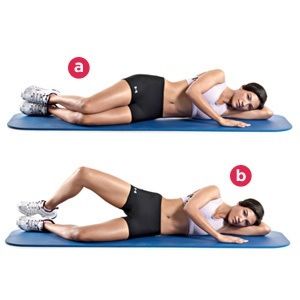
Hip lifts
- Begin by lying down with your legs hip-width apart, your feet flat on the floor, and your knees bent.
- Maintain a comfortable posture with your arms resting by your sides.
- Glute contraction will raise your hips.
- Instead of raising your entire weight to your neck, maintain your weight on your shoulder blades.
- Additionally, maintain a forward-leaning knee stance and parallel upper thighs while engaging your inner thighs.
- At the top, take a breath and pause before stepping back down to the starting position.
- Then relax.
- Perform complete this exercise five or ten times.
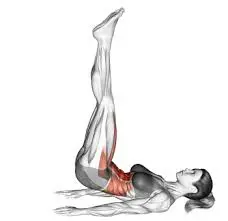
Donkey kick
- Starting on all fours, place your hands under your shoulders, place your legs hip-width apart, and maintain a neutral neck and spine.
- With your knee bent, raise your left leg behind you while bracing your core.
- Press your foot straight up toward the ceiling with your glutes, like you’re leaving an imprint there.
- When you get to the top, tighten your glutes even more.
- Make sure your hips remain in line with the floor.
- If necessary, tap your knee on the floor to get back to the beginning position.
- For added intensity, try floating your knee in between repetitions.
- Then relax.
- Work through this exercise five or ten times.
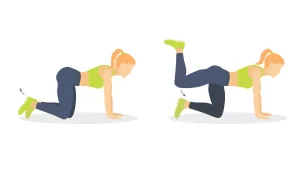
Side Shuffle with Resistance band
- Keep your back straight while you spread your feet shoulder-width apart.
- Tie a miniband around your upper thighs.
- Move your butt back and flex your knees just a little.
- Start by taking small measures to tighten the band on your right side.
- For the number of repetitions indicated, repeat the movement.
- Proceed in the direction of your left side.
- Concentrate on moving slowly and deliberately.
- Always make sure your knees are facing in the direction of your toes.
- You should always have a forward-facing head and chest.
- Once the exercise is complete, get back up to a standing position.
- Then relax.
- Run through this exercise five or ten times.
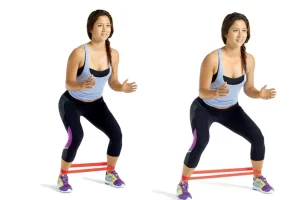
Lunge Kickback with Resistance band
- To perform a lunge, step forward with your left leg and bend both knees at a 90-degree angle, making sure your left knee is in line with your left ankle.
- Maintaining an upright posture, raise your right leg behind you and shift your weight to your left leg.
- Reposition your right leg to its starting position.
- Then repeat this movement for a few seconds.
- After a few seconds, rest.
- Once the exercise is complete, get back up to a standing position.
- Then relax.
- On the other side, repeat the same motion.
- Run through this exercise five or ten times.
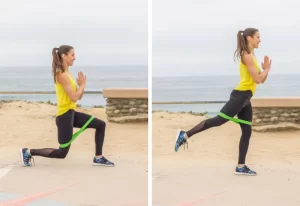
Standing Hip Abduction with Resistance band
- The resistance band should be looped around your ankle and a strong object on the other end.
- Using your inside arm to grip the sturdy object, stand tall with the ankle looped furthest from the other end of the band.
- As much as you can, raise and extend your outer leg straight out to the side.
- After pausing, raise your leg back to the beginning position.
- After finishing the exercise, return to a standing position.
- Next, unwind.
- Continue with the same approach on the opposite side.
- Perform the exercise five or ten times.
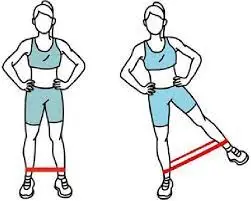
Bridge Thrust with Resistance band
- Choose a resistance band that is suitable for the level of fitness you possess.
- With your knees at a right angle and your back flat against the floor, take a floor position.
- The resistance band should be wrapped around both thighs so that it sits slightly above your knees.
- Raise your hips toward the sky, squeeze your knees out against the bands, and keep your arms at your sides.
- Tension your muscles, hold it for two to three seconds, then let go.
- After finishing the exercise, return to a standing position.
- Next, unwind.
- Perform this drill five or 10 times.
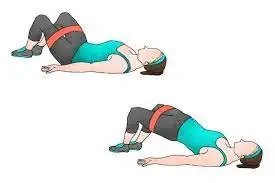
Plank Kickback with Resistance band
- Using your hands, grasp the opposite end of the resistance band while you encircle your right foot.
- Drop on your hands and knees in step two.
- With your right foot within the band, hold the band tight and kick back.
- Your leg ought to move straight from bent to locked out.
- After finishing the exercise, return to a standing position.
- Next, unwind.
- Repeat the instructions with a different leg after completing the required number of repetitions.
- Perform this drill five or ten times.
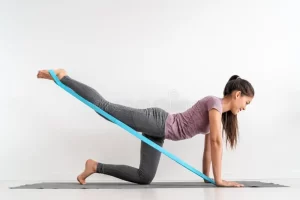
Sumo walks( lateral walk with resistance band)
- Place the band slightly above each ankle and wrap it around both legs, making sure it is flat and not coiled.
- Your feet should be shoulder-width apart.
- Not stretched, yet tight is how the band should be.
- To engage your muscles, slightly bend your knees and lower yourself into a half-squat.
- Face forward, maintain your feet parallel to your shoulders, and distribute your body weight equally over both feet.
- While keeping your weight on one leg, take a step backward with the other leg to continue the half-squat position.
- Maintain a level hip throughout the exercise.
- It’s beneficial to keep your posture low and forward-facing during this workout.
- Instead of rounded, your back should be straight.
- Change your legs and move your weight slowly.
- After finishing the exercise, return to a standing position.
- Next, unwind.
- Perform this drill five or ten times.
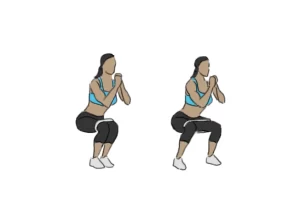
Fire Hydrants
- On a smooth and cushioned surface, go to all fours.
- Ideally, your hands should be just beneath your shoulders and your knees under your hips.
- Make sure you have the correct posture back.
- When you’re ready, release the tension in your lower body by straightening your right knee and lifting it out to the side.
- As you lift the knee, maintain a 90-degree bend in your right leg.
- Elevate your knee until it touches your hips.
- After one to two seconds of intense hip contraction, progressively return to the starting position.
- Next, unwind.
- Repetition Start with five to ten fire hydrants using your right leg, and then repeat with your left leg.
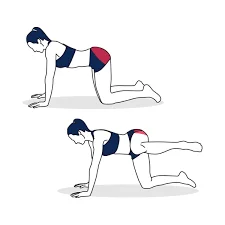
Hip Thrust
- Position yourself so that your knees are bent and your feet are flat on the floor, with your back against an elevated surface (such as a bench or box).
- Your feet should be shoulder-width apart, and the bench should rest directly below your shoulder blades.
- Maintaining a tucked chin, drive through your heels to bring your thighs parallel to the ground; your legs ought to be at a 90-degree angle.
- At the top, tighten your glutes, then go back to the beginning.
- Next, unwind.
- Perform this drill five or ten times.
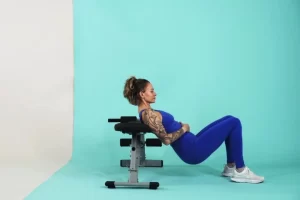
Single-Leg Glute Bridge
- Relax on your back on a mat with your feet flat on the floor and your knees bent.
- Keep your hands by your sides and your feet hip-distance apart.
- Place the leg on top of the healthy leg, as shown in the figure.
- Raise your hips so they are in line with the ceiling.
- Stop when your thighs and hips are parallel to one another.
- Keep the position for three to five seconds, or for as long as feels comfortable.
- Retain your breath.
- Lower your hips progressively.
- Lift your hips up before they make contact with the floor again.
- Next, relax.
- This practice should be added to five or ten times.
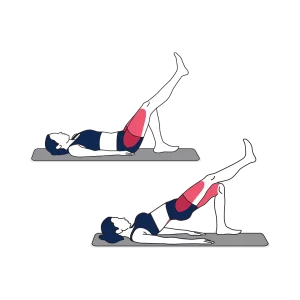
Romanian Deadlift
- Position your feet beneath your hips and take a lofty stance.
- Place your weight in front of your thighs, such as a barbell or dumbbell.
- Keep your shins vertical to the floor and your knees exactly above your heels.
- Maintain your head alignment and your shoulder blades pointing in the same direction as you reduce the weight.
- Your hamstrings should feel stretched.
- To get back to the beginning position, thrust your hips forward once the weight is below your knees.
- Next, unwind.
- Perform this drill five or ten times.
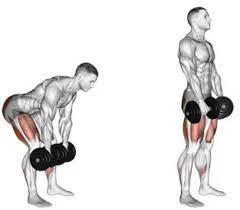
Squat Hip Abduction
- Place your feet slightly wider than hip-width apart and lower yourself into a squat.
- For strengthening you can use resistance therabend.
- Next, extend your right leg.
- Allow your hips to reposition to suit this action.
- After that, take a step back and move your left leg in the same manner.
- Throughout this action, make sure you only take four steps: left leg out, left leg back, right leg out, and right leg back.
- For optimal results, keep your squat position at the same depth.
- Next, unwind.
- Perform this drill five or ten times.
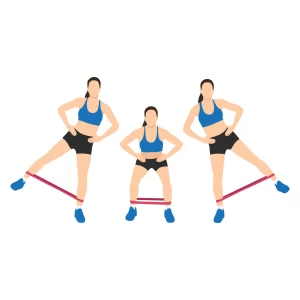
Side Leg Lifts
- On a mat or other small, soft surface, lie down.
- Now turn to the right, keeping your head, neck, and back in a neutral position.
- For support, place your hand beneath your arm and bring it up to your head for a comfortable position.
- Place your legs one above the other now.
- Raise your left leg as high as you can slowly and keep it there for a single second.
- Now slowly place it down on your other leg.
- After finishing the exercise, return to the starting position.
- Next, unwind.
- Perform this drill five or ten times.
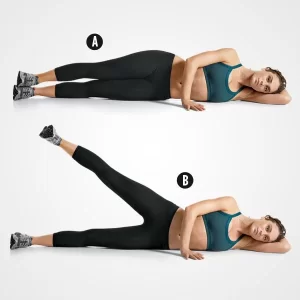
Hip circles
- Elevate one leg to balance while standing on the other.
- Rotate the raised leg in a circle.
- Make 15 to 20 circles in each direction.
- Go to the other leg now.
- After finishing the exercise, return to the starting position.
- Next, unwind.
- Perform this drill five or ten times.
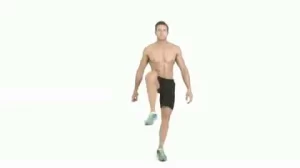
Step up with weights
- Carry a weight in each hand while you stand with your feet at hip-width apart.
- Keeping your weight at your side, force your left knee up as you step onto a chair or step with one foot.
- Step off the chair or step backward and lower your left leg.
- Then switch to the other leg.
- After finishing the exercise, return to the starting position.
- Next, unwind.
- Perform this drill five or ten times.
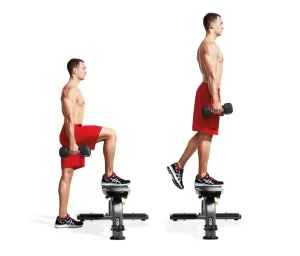
Frankenstein walk
- Keeping your hands facing down, raise your arms in front of you.
- As you go forward, swing your right leg straight up and out to form a 90-degree angle with your body.
- After dropping your right leg to the floor, swing your left leg up in the same way.
- If you reach out of place, continue for another minute or so and change the direction you are going.
- After finishing the exercise, return to the starting position.
- Next, unwind.
- Perform this drill five or ten times.
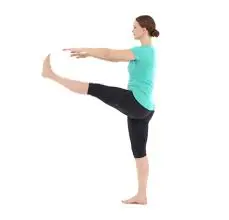
Stair climbing
- Put on well-fitting, cozy shoes with adequate cushioning and support within.
- To reduce the chance of falling, wear exterior soles that are not slick.
- Select well-built stairs with adequate illumination.
- While climbing, keep your shoulders and neck relaxed and correct.
- Avoid arching your back.
- Aim to ascend as silently as you can; making loud noises when doing so suggests that your knees and other joints are being overworked.
- Avoid attempting an excessively rapid ascent; instead, maintain a gradual and even pace, pausing as needed.
- Don’t attempt to climb by skipping stairs.
- Instead of trying to do a lot of steps all at once, you should gradually increase your stamina over a few weeks to avoid hurting yourself.
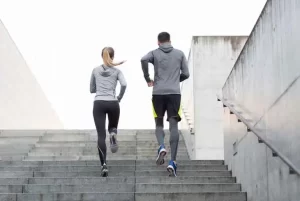
Pigeon poses
- Start by taking a comfortable seat and placing your hands on your knees on the ground.
- Now contract your abdominal muscles.
- Next, bend your left knee to the side and forward.
- Bend your right toes below and swing your right leg back.
- Toes apart on the left side.
- Keep your back straight and raise your gaze.
- Hold this posture for a short while.
- Then take a cautious step back to your neutral position.
- Next, unwind.
- Five to ten times more, repeat.
- On the opposite leg, repeat the exercise.
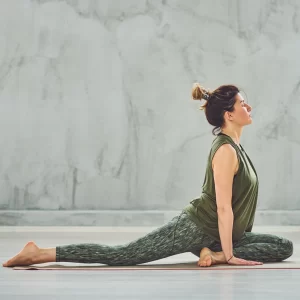
Side Plank Hip Dips
- Start on your hands and toes in the standard plank position.
- Make sure your shoulders are squarely beneath your hands.
- Raise your left hand off the floor, then turn your entire body to face left.
- Your right side should be completely toward the ground.
- To maintain your hip raised and the right side of your body in a single, extended line, contract your right obliques.
- When you’re prepared, release the breath and lower your right hip a few inches to the ground.
- Hold for a moment or two.
- To raise your hips back up, inhale and contract your right oblique muscles.
- After finishing the exercise, return to the starting position.
- Next, unwind.
- Perform this drill five or ten times.
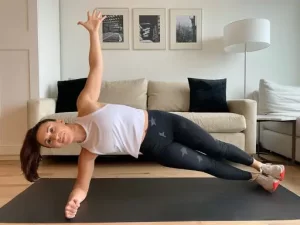
Hip marching
- Take a seat at the end of the bench nearest you.
- Raise one leg as high as you can while maintaining a bent knee.
- Drop your leg with deliberate, gradual motions.
- After finishing the exercise, return to the starting position.
- Next, unwind.
- Perform this drill five or ten times.
- Continue with the opposite leg.
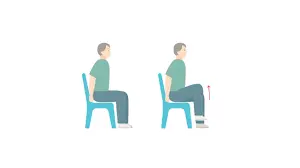
Crab walk
- Starting from the floor, place your feet hip-distance apart in front of you, place your arms behind your back, and face your hips with your fingers pointing that way.
- To protect your back, make sure to maintain your feet wide apart, your abdominal muscles contracted, and your palms on the floor behind your butt.
- Lift your hips above the ground and squeeze your core.
- Move your left hand first, then your right foot, then finally your right hand, then your left foot, to begin “walking” ahead.
- When room permits, take four or more steps, then turn around.
- For however long is necessary, keep going back and forth.
- After finishing the exercise, return to the starting position.
- Next, unwind.
- Perform this drill five or ten times.
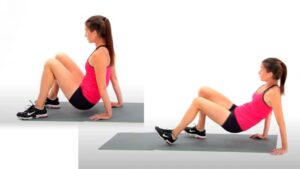
External Hip Raise
- Surround your ankles with a tiny resistance band.
- Lie on your left side and support your upper body with your left hand and forearm.
- Extend both legs out with your feet flexed.
- Tighten abs and raise top leg to hip height, turning leg to turn toes down to the floor while preserving tension on the band.
- Lift one leg slightly higher than hip height, pulling on the band and rotating the heel up to the ceiling.
- Return the leg to hip level.
- After finishing the exercise, return to the starting position.
- Next, unwind.
- Perform this drill five or ten times.
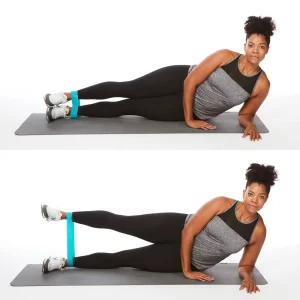
Chair pose arm forward
- Having your feet together and your arms by your sides, assume a straight stance.
- With your palms pointing down, extend your hands forward.
- Keep your elbows straight.
- Bend your knees and tuck your pelvis down, as though you were seated on a chair.
- To further understand the Chair Pose, picture yourself sitting still and reading a newspaper or typing on a laptop.
- Make sure your hands remain parallel to the floor.
- Sit upright and extend your spine mindfully.
- Slowly lower yourself into the chair such that your knees don’t extend past your toes as you do so.
- Continue descending gradually, then take a seat in This pose.
- Then relax.
- Perform complete this exercise five or ten times.
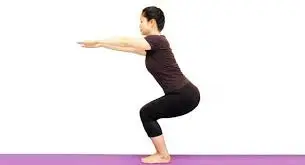
Duck walk
- Place both hands on your head and lower yourself into a squat.
- Step starting to the right. You can walk three steps farther.
- Take three extra steps to return to the left.
- Maintain as low as you can to get the best outcomes.
- After finishing the exercise, return to the starting position.
- Next, unwind.
- Perform this drill five or ten times.
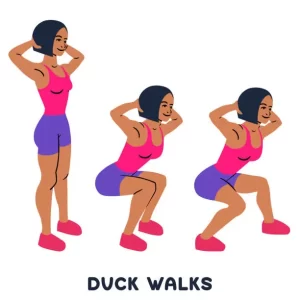
Exercise safely by following these guidelines:
By adopting these precautions, you may reduce your chance of injury and ensure a safe and effective workout regimen for the muscles surrounding your hips.
- Don’t take part in an activity if it makes you uncomfortable.
- To avoid overexertion and muscular pain, gradually increase the repetitions and length of your exercises.
- Using the right tools would be ideal.
- During workouts, keep the correct process in mind because Incorrect forms might cause damage and fail to get the desired effects.
- Put on comfortable shoes and loose-fitting clothing.
- Before working out, make sure your body is fully warmed up.
- While exercising, be mindful of any pain or irritation.
- Stop the workout immediately if you feel any sharp pain or discomfort and consult a healthcare practitioner.
- You should take enough time off in between workout sessions; this rest allows your muscles to relax.
- To stay hydrated and maintain maximum muscle function, drink lots of water before, during, and after your workout.
When was the patient no longer allowed to participate in the exercise protocol?
- People who experience muscle aches shouldn’t work.
- Sleep-deprived people could choose not to work out.
- If numbness or discomfort are present.
- Temperature increase
- Headache
- Exercise ought to be stopped if it hurts.
- If throughout this exercise the patient experiences any aches or pains.
Conclusion
You can’t naturally alter the bone structure you were born with. Still, you can rearrange your hips and tummy to highlight an hourglass figure by exercising carefully and maintaining a balanced diet. These workouts are the first step on the road to hips.
For best results, disregard all other advice and adhere to these workouts away. Although you are unable to precisely tone or focus on the pelvic area; having strong hips is essential for a lower body that is more sturdy and healthy.
The mentioned workouts are among the greatest for getting broader hips. While it is impossible to tone or precisely target the pelvic region, developing strong hips is essential for a more robust and healthy lower body.
You may increase muscle and expand your hips by combining hard lifting and proper form. Even when targeting the hip area, exercise can provide numerous benefits. It is possible to increase hip width and gain muscle by doing heavy lifting exercises with proper form. It’s almost a blessing in secret to have wider, more appealing hips, but one can do this by exercising and training in a certain way to lose fat and develop firmer, rounder hips.
FAQs
Should I work on my hips?
By strengthening your hips, nonsurgical treatments like exercise can dramatically reduce pain. Exercises that target specific areas strengthen the muscles, ligaments, and tendons that support hip mobility.
Which workout is ideal for expanding the hips?
Side lunges
Squats
Bulgarian split squats
Clamshells
Hip lifts
Frankenstein walk
Romanian Deadlift
Do large hips promote health?
It is not healthy or better to have small hips. Wider hips might be better, especially for women. Leaner hips can be achieved by engaging in a workout regimen that targets your lower body as well as your total body fat.
Do hips naturally enlarge?
Since your bone structure plays a major role in determining the breadth of your hips, there are no natural methods to dramatically broaden them. However, workouts like lunges, squats, and hip abductor movements might help you concentrate on developing muscle in the hip and glute area.
How Can My Hips Become Wider?
The muscles in your waist and hip area will get stronger and more toned with certain activities. They consist of fire hydrants, side lunges, and squats.
How can my weak hips get better?
Standing Hip Abduction.
Single-Leg Squat.
Single-Leg Glute Bridge.
Romanian Deadlift.
Are your hips in good health?
For the majority of movements, including bending, walking, jogging, and sitting, healthy hips are essential. Your daily activities may be seriously hampered by hip discomfort. Numerous conditions, such as rheumatic disorders affecting the joints and connective tissues, such as arthritis, can cause hip pain.
Which muscle makes your hips grow?
The gluteus maximus, gluteus medius, and gluteus minimus comprise the group of muscles known as the gluteal muscles, which are located in the buttock region. The majority of the contour and form of the buttock and hip region is formed by the gluteus maximus, the largest and most superficial of the three muscles.
Is It Possible to Exercise Your Way Toward Wider Hips?
The bone structure you were born with cannot be altered naturally. However, you can alter your hips and tummy to highlight an hourglass figure by exercising carefully and maintaining a balanced diet.
What muscles should you work on to achieve the appearance of broader hips?
Gluteus maximus.
Glute medius.
Glute minimus.
Tensor fasciae latae.
Can I do hip exercises daily?
Yes, you can practice hip exercises every day, but to avoid overuse issues, you should change the intensity and concentration of your workouts. Include rest days as well, and pay attention to your body for signals of exhaustion or strain.
Is having wider hips a good thing?
It is not healthy or better to have small hips. Wider hips might be better, especially for women. Leaner hips can be achieved by engaging in a workout regimen that targets your lower body as well as your total body fat.
References:
- Cpt, T. C. May 30, 2023. Is It Possible to Exercise Your Way Toward Wider Hips? Exercises for the hips: https://www.healthline.com/health/fitness-exercise/how-to-get-wider-hips Citation inside text: (Cpt, 2023)
- Atemi Sports. 10 Exercises You Can Do at Home to Get Wider Hips (2023, April 19). T The following is an in-text citation for Atemi Sports’s “10 Exercises for Wider Hips You Can Do at Home”: https://atemi-sports.com/exercises-for-wider-hips/
- Colletta, M. (October 13, 2021). 10 Incredible Exercises to Help You Get Wider Hips. Steel Additives. https://steelsupplements.com/blogs/steel-blog/ten-awesome-exercises-for-wider-hips Reference within the text: Colletta, 2021
- Bajaj, A. January 3, 2023. Five Powerful Exercises for Broader Hips. Sportskeeda. Five efficient exercises to achieve broader hips: https://www.sportskeeda.com/health-and-fitness Citation within the text: (Bajaj, 2023)
- Speck, C. (January 26, 2021). 10 Workouts That Will Help Your Hips Get Wider. Fitplan Blog. In-text Citation: (Speck, 2021) https://blog.fitplanapp.com/how-to-get-wider-hips-10-effective-exercises
- P. Bansal (n.d.). Onlymyhealth.com/exercises-for-wider-toned-hips-1629289826. Five Exercises To Get Wider And Toned-Up Hips Reference within the text: Bansal, n.d.
- R. R. E. H. A. N., Surgeon (2021, November 5). Which Exercise Is Ideal for Your Hips? fifteen hip exercises. MedicineNet. What’s the Best Workout for Your Hips? https://www.medicinenet.com/article.htm Citation within the text: Surgeon (2021)
- Image 2, Lunge, Curtsy (n.d.). Curtsy Lunge: https://ar.inspiredpencil.com/pictures-2023 Citation inside the text: (Curtsy Lunge, n.d.)
- Image 9, Shuffle-lateral-wind. (n.d.). The Trainer in Humanity. In-Text Citation: (Lateral-shuffle-band, n.d.) https://www.thehumantrainer.com/resistance-band-workout-to-help-strengthen-your-knees/lateral-shuffle-wband/
- Image 10, C. (July 1, 2017). Resistance Band Booty Workout for 15 Minutes. Physical Kitchness. 15-minute resistance band booty workout. https://physicalkitchness.com/ In-text Reference: (2017)
- Image 13, M. (not available). Resistance band fitness gal using rubber strap elastic for donkey kick floor exercises and leg workouts. gluteal muscle. Dreamtime.net. Resistance band fitness girl working out her legs, donkey, kick, and performing floor exercises with a rubber strap and elastic glute activation muscle (image 207868409) In-text Reference: (n.d.)
- Image 16, Falk, M. January 6, 2023. To Increase Lower Body Strength at Any Fitness Level, Try These 7 Hip Thrust Variations. Form. hip-thrust-variations-7089684 on Shape.com Citation inside the text: Falk (2023)
- Image 19, Putra, L. (January 13, 2022). Get the free download “Woman performing leg abduction exercise with resistance bands.” The image has been sourced from Vecteezy. The vector art depicts a woman performing a resistance band squat and leg abduction workout. Citation inside the text: Putra, 2022
- Image 21, hip circle when standing. March 5, 2015. Male Health. Standing Hip Circle: https://www.menshealth.com/uk/fitness/a753427 Reference within the text: Standing Hip Circle (2015)
- Image 24, Chakrabarti, C. (2020, October 21). There Are Significant Health advantages From Climbing Stairs. Sportz Business. https://www.sportzbusiness.com/climbing-stairs-can-produce-huge-benefits-for-your-body/ In-Text Citation: (Chackravarthi, 2020)
- Image 29, Smith, J., and B. Stephens (2022, August 29). 11 Best Hip-Strengthening Exercises. Shape. https://www.shape.com/fitness/workouts/6-moves-slimmer-hips-and-thighs Citation: (Smith & Stephens, 2022)
- Image 30, R. (2017, December 28).Chair Pose | Utkatasana Steps, Benefits, and Precautions | Eyogaguru. eYogaguru.com. https://eyogaguru.com/chair-pose-utkatasana-steps-benefits-precautions-eyogaguru/ In-Text Citation: (2017)
- Image 31, C. (January 15, 2019). Duck trots. Bend over. Physical activity. glimpses of women in action… Instagram. A woman is shown exercising and training in these silhouettes: https://www.istockphoto.com/vector/duck-walks-squat-sport-exercise-training-gm1094508668-293759610In-text Reference: (2019)

